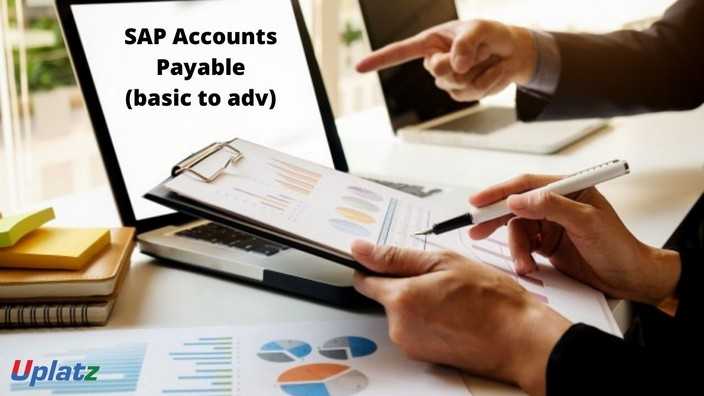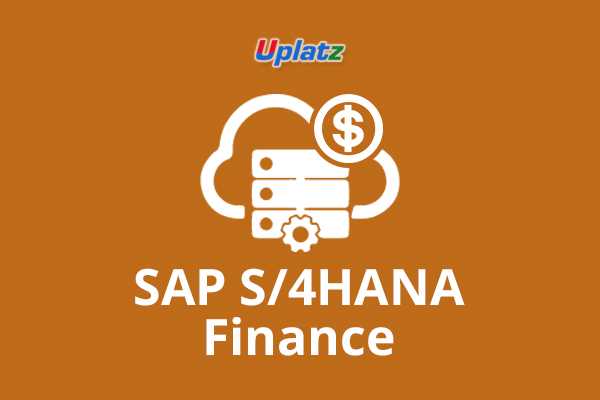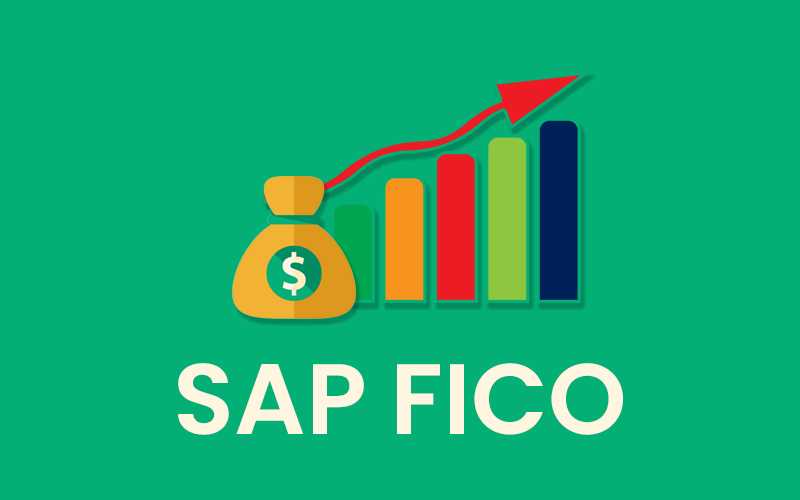SAP Accounts Payable (basic to advanced)
Mastering SAP Accounts Payable: Streamlining Vendor Transactions and Financial Control in the ERP Landscape. Become a top SAP Finance/FICO Consultant. View Course Curriculum
Price Match Guarantee
Full Lifetime Access
Access on any Device
Technical Support
Secure Checkout
Course Completion Certificate
View Course Curriculum
Price Match Guarantee
Full Lifetime Access
Access on any Device
Technical Support
Secure Checkout
Course Completion Certificate
 73% Started a new career
BUY THIS COURSE (
73% Started a new career
BUY THIS COURSE (GBP 12 GBP 29 )-
 79% Got a pay increase and promotion
79% Got a pay increase and promotion
Students also bought -
-

- Premium Career Track - Chief Financial Officer (CFO)
- 600 Hours
- GBP 39
- 3623 Learners
-

- SAP S/4HANA Finance
- 20 Hours
- GBP 12
- 566 Learners
-

- SAP FICO (Finance and Controlling)
- 30 Hours
- GBP 12
- 5666 Learners

SAP Accounts Payable is an important component of SAP FICO elements that records and manages accounting data of seller. SAP Accounts Payable is also known as a sub-ledger accounting, as the business transactions are carried out individually in the vendor accounts. All the prepared transactions in accounts payable are recorded directly in the general ledger account. The real time updates are done in the application through settings made in general ledger master while creation of account. The required settings are arranged by choosing vendors for settlement account for each account type. Any posting done in accounts payable generates a respective posting to an assigned general ledger account ensuring that the sub ledgers are always reconciled with the general ledger.
In SAP Accounts Payable, sundry creditors are called accounts payable and sundry debtors are called accounts receivable. The deliveries and invoices are managed according to the vendors. SAP FICO SAP Accounts Payable (basic to advanced) can be merge with FI-GL (General Ledger), FI-AA (Asset Accounting), SAP MM (Materials Management), and the like.
The Accounts Payable (AP) module in SAP is a key component that handles the company's financial transactions related to vendors and suppliers. Here are some key aspects of SAP Accounts Payable:
-
Master Data Maintenance
- Vendor Master Records: In SAP AP, vendor master records are created and maintained to store information about the company's vendors and suppliers. This includes details such as vendor name, address, payment terms, and other relevant information.
-
Invoice Processing
- Invoice Entry: SAP AP allows users to enter vendor invoices into the system. Invoices can be entered manually or through electronic data interchange (EDI) interfaces.
- Invoice Verification: The system verifies invoices against purchase orders and goods receipts to ensure accuracy. It also checks for duplicate invoices and validates them based on predefined rules.
-
Payment Processing
- Payment Run: SAP AP facilitates the creation of payment proposals and the execution of payment runs. Payment proposals include invoices due for payment, and the payment run generates payment documents for those invoices.
- Payment Methods: Different payment methods, such as checks, electronic funds transfer (EFT), and wire transfers, can be configured in SAP AP to accommodate various payment preferences.
-
Document Handling
- Document Parking: Users can park incomplete or draft documents in the system before finalizing them. This allows for collaborative work and validation before posting.
-
Reporting and Analytics
- SAP AP provides various standard reports and analytics to help users monitor and analyze accounts payable transactions. Examples include aging reports, open item reports, and vendor analysis reports.
-
Integration with Other Modules
- SAP AP is tightly integrated with other SAP modules, such as Materials Management (MM) and General Ledger (GL). Integration ensures a seamless flow of information between different business processes.
-
Automatic Payment Program (APP)
- The Automatic Payment Program is a powerful feature that automates the payment process based on predefined criteria, such as payment terms and due dates. It helps in streamlining the payment process and reducing manual intervention.
-
Withholding Tax
- SAP AP supports the calculation and posting of withholding tax on vendor invoices in accordance with tax regulations.
-
Workflow and Approvals
- SAP AP supports workflow functionality to streamline approval processes for invoices, ensuring that the necessary stakeholders review and authorize payments.
The SAP Accounts Payable (basic to advanced) course by Uplatz provides a comprehensive knowledge on end-to-end processes involved in Accounts Payable sub-module of SAP FICO.
Course/Topic - SAP Accounts Payable (basic to adv) - all lectures
-
In this SAP Accounts Payable video, you will learn Accounts Payable submodule in SAP FICO step by step from basics to advanced concepts with scenarios. At the end of the video, you will be able to recognize the scope and function of accounts payable, or the AP sub component of financial accounting.
-
In this video you will understand any postings made in Accounts Payable is updated in General Ledger as well. The Accounts Payable submodule has tons of reports and forecasting to features to track vendor outstanding and payments.
-
SAP Accounts Payable is one of the important components of SAP Financial (FI) Module. It represents as FI-AP respectively. This video contains the details about those modules.
-
In this video, you will learn about Manual Bank reconciliation statement which is reconciliation between the account maintained by your company and the account maintained by the bank.
-
The Data cap Accounts Payable application uses optical character recognition and location rules to capture invoice data.
-
Check management is used in cases where, when issuing your checks, you do not want to use the payment document number as the check number, but a different numbering method instead.
• Become familiar with the basic concepts of General Ledger Accounting, Accounts Receivable, and Accounts Payable.
• Acquire knowledge to set up business processes in the above areas.
• Be able to process vendor invoices and settlement of payments
• Be able to produce queries on vendor accounts and document transactions by generating different reports in AP
• To gain an overview of sound business practice in this area, and of
integration of AP with other areas and modules in the SAP R/3
SAP Accounts Payable (basic to advanced) - Course Syllabus
1. Create vendor master record
2. Change/Display vendor master record
3. Change vendor with confirmation
4. Block/Unblock vendor
5. Display changes
6. Post vendor invoice
7. Display document
8. Display account balance/line items
9. Post outgoing payment with automatic clearing
10. Post outgoing payment with minor variance
11. Post outgoing payment and print check
12. Payment run
13. Void check
14. Vendor Information System
15. Vendor Balances
16. Vendor List & Address List
The SAP Accounts Payable Certification ensures you know planning, production and measurement techniques needed to stand out from the competition.
SAP FI Accounts Payable is used to manage and record accounting data for all the vendors. All invoices and deliveries are managed as per vendor requests. Payables are managed as per the payment program and all the payments can be made using checks, transfer, electronic transfers, etc.
Accounts Payable (AP) is an important application of SAP FICO module that helps to record and manage accounting data of all vendors. In SAP, sundry creditors are called accounts payables and sundry debtors are called accounts receivable.
Advertisements. SAP FI Accounts Receivable component records and manages accounting data of all customers. It is also an integral part of sales management. All postings in Accounts Receivable are also recorded directly in the General Ledger.
The Statutory Accounting Principles (SAP) are accounting regulations for the preparation of an insurance firm's financial statements. The focus of SAP is to ensure the solvency of insurance firms so that they are able to meet the obligations to their policyholders.
Uplatz online training guarantees the participants to successfully go through the SAP Accounts Payable Certification provided by Uplatz. Uplatz provides appropriate teaching and expertise training to equip the participants for implementing the learnt concepts in an organization.
Course Completion Certificate will be awarded by Uplatz upon successful completion of the SAP Accounts Payable online course.
The SAP Accounts Payable draws an average salary of $120,000 per year depending on their knowledge and hands-on experience.
Nearly every large company has an accounts payable department responsible for paying business expenses to creditors and suppliers. If you have an interest in finance and managing costs for a business, working in accounts payable may be a good option for you.
SAP FI Accounts Payable is used to manage and record accounting data for all the vendors. All invoices and deliveries are managed as per vendor requests. Payables are managed as per the payment program and all the payments can be made using checks, transfer, electronic transfers, etc.
Note that salaries are generally higher at large companies rather than small ones. Your salary will also differ based on the market you work in.
Accounts Payable Processor.
GDS Talent Procurement Regional Lead 1.
Associate-Procure to Pay Processing.
Question 1. Explain ‘customer/vendor Master Records?
Answer :
There are three categories of data maintained in a typical master record for a customer:
- General Data
- Company Code Data
- Sales Area Data (for customers)/Purchasing Organization Data (for vendors)
General Data includes general information such as account number, name, telephone, bank information, trading partner, vendor (if the customer is also a vendor), group key, bank key, bank account, alternate payee, etc., which are common to all the Company Codes using this master. Company Code Data comprises terms of payment, payment methods, tolerance group, clearing with vendor, dunning data (dunning procedure, dunning recipient, dunning block, dunning clerk, etc.), reconciliation account, sort key, sales area (purchasing organization in the case of vendor master), head office, etc. Except for sales (purchasing) related information, all other details are usually maintained for the finance people who can also access the sales data when the master is maintained ‘centrally.’
Sales Area Data in the Company Code area of a Customer master record contains the following:
- Order-related data (sales district, sales office, sales group, customer group, etc.)
- Price-related data (pricing group, pricing procedure, etc.)
- Shipping data (shipping strategy, delivery priority, etc.)
- Billing data (payment terms (different from the payment terms maintained at the Company Code level), account assignment group, etc.)
Purchasing Organization Data in the Company Code area of a Vendor master record contains the following:
- Conditions (order currency, payment terms, Incoterms, minimum order value, etc.)
- Sales data (a/c with Vendor)
- Control data (as in the screen shot below)
During creation of a master record, the system checks for ‘duplicates’ for the same customer which is achieved by the system through the ‘Search-Id’ (Match Code) configured on the customer’s address information.
As in the case of the GL account master record, the creation of the customer/ vendor master record is also controlled by the ‘Account Group,’ which is called ‘Customer Account Group/Vendor Account Group’ (CPD/CPDL/KREDI/LIEF) and controls the numbering of customer/vendor master records, field status, whether an account is a regular one or a ‘One Time’ account, etc.
Open table as spreadsheet Activity in Accounting Centrally Customer Vendor Customer Vendor
Create FD01 FK01 XD01 XK01
Change FD02 FK02 XD02 XK02
Display FD03 FK03 XD03 XK03
Block/Unblock FD05 FK05 XD05 XK05
Mark for Deletion FD06 FK06 XD06 XK06
Question 2. Who Is An ‘alternate Payee’?
Answer :
A customer who pays on behalf of another customer is known as an ‘Alternate Payee’ (or Alternate Payer). Though the alternate payee pays on behalf of another, the system maintains all the transaction details in the account of the original customer. Designating ‘alternate payee’ does not absolve the customer of his/her obligation for payment.
The ‘alternate payee’ can be maintained in Client-specific data or in the Company Code area. When maintained in the Company Code area you can use that payer only in that Company Code; if defined at the Client level you can use it across all Company Codes. There are three ways to ‘select’ the alternate payee when an invoice is processed:
1. The alternate payee (say, 1000) entered in the customer master record is the one selected by the system as the default.
2. When there is more than one alternate payer (say, 1000, 1900, 2100, etc.) defined for a single customer in the master record (you will do this by clicking on the ‘allowed payer’ button and create more than one payer), you may select a payer (say, 2100) (other than the default, 1000) while processing the invoice. Now the system will ignore the alternate payer (1000) coming from the master record.
3. If you have put a check mark in the ‘individual entries’ check box in the ‘alternate payer in document’ section in the customer master record, then this will allow you to propose a new alternate payer, say, 3000 (other than those already defined in the system). Now, after defining this alternate payer you can use it to process the invoice. In this case, the alternate payer (3000) takes precedence over the payers (1000 and 2100) in step 1 and 2 above.
Question 3. What Is The ‘trading Partner’ Concept?
Answer :
The ‘Trading Partner’ concept is used to settle and reconcile ‘inter-company transactions,’ both sales and purchases. This is generally achieved by entering the Company-ID (not the Company Code) to which a customer belongs in the ‘trading partner’ field under the tab ‘Account Control’ in the customer master record. You can do a similar entry in the vendor master record.
Question 4. Explain ‘tolerance’ In Transaction Processing?
Answer :
‘Tolerances’ are defined in the system to facilitate dealing with the differences arising out of accounting transactions and to instruct the system on how to proceed further. Normally, you define tolerances (either in ‘absolute terms’ or in ‘percentages’) beyond which the system will not allow you to post a document should there be a difference.
In SAP, tolerances are defined per Company Code and there are several types:
- Employee tolerance
- Customer/vendor tolerance
- GL account clearing tolerance
You will define an ‘employee tolerance group’ in the system and assign the employees to these groups.
While defining the tolerance group you will specify:
1. Upper limits for various posting procedures
- Amount per document
- Amount per open account item
- Cash discount, in percentage
2. Permitted payment differences
How much over or under payment an employee is allowed to process. This is defined both in absolute values and in percentages. Besides defining the above two, at the Company Code level, you will also define similar tolerances for customer/vendor tolerance group. Once defined, each of the customers (vendors) is assigned to one of these groups. Here also, you define the ‘permitted payment differences’:
While processing, the system compares the tolerance of an employee against the customer tolerance (or vendor tolerance or the GL) and applies the most restrictive of the two.
Question 5. What Is ‘dual Control’ In Master Records?
Answer :
‘Dual Control’ helps to prevent unauthorized changes to the important and ‘sensitive’ fields in the master records in the system. (All such sensitive fields are defined in the Table T055F when customizing the application. And these fields are defined per Company Code and per Client.) Consider, for example, a sensitive field such as ‘payment block’ in a vendor master record. When a user changes this field’s content, the system requires another user (usually of higher authority) to approve this change and an audit trail is maintained of all such changes. Unless ' the change is approved, in this example, this particular master is blocked by the system for considering the same in the next ‘payment run.’
Open table as spreadsheet Activity Customer Vendor
Display changes (accounting area) FD04 FK04
Display changes (centrally) XD04 XK04
Confirm changes, individually FD08 FK08
Confirm changes, in a list FD09 FK09
Question 6. What Is A ‘bank Director’ In Sap?
Answer :
SAP stores the master data (details such as bank key, bank name, bank country, bank address, and so on) relating to the banks in the ‘Bank Directory’ (Table: BNKA). Remember, the ‘bank masters’ are not created in the application but in the implementation side using the IMG. (Of course, you can also create the bank master in the application side in FI-TR and not in FI-GL or AP or AR.) However, if you are in the process of creating a master record for a vendor or a customer and you enter some bank details, which the system does not find in the ‘Bank Directory,’ then the system automatically brings in the relevant screens for you to maintain and update the bank details in the bank directory.
You may create the bank directory in two ways:
1. Manually (IMG path: Financial Accounting>Bank Accounting>Bank Accounts>Define ‘House Banks’)
2. Automatically (by importing the bank details using a special program)
Question 7. What Is A ‘house Bank’?
Answer :
‘House Bank’ is the bank (or financial institution) in which the Company Code in question keeps its money and does the transactions from. A house bank in SAP is identified by a 5 character alphanumeric code. You can have any number of house banks for your Company Code, and the details of all these house banks are available in the ‘bank directory.’
Each ‘house bank’ in the system is associated with a country key (U.S., IN, etc.) representing the country where the bank is located, and a unique country specific code called a ‘bank key.’ The system makes use of both the ‘country key’ and the ‘bank key’ to identify a ‘house bank.’
- For each of the ‘house banks,’ you can maintain more than one bank account; each such account is identified by an account ID; i.e., Chek1, Check2, Pybl1, etc. Here, ‘Chek1’ may denote Checking account 1, ‘Pybl1’ may denote Payables account 1, and so on. You may name the accounts in a way that it is easily comprehensible. The ‘Account ID’ is referenced in the customer/vendor master record and it is used in the payment program by the system.
- For each ‘account ID’ you will also specify the bank account number (maximum length of this identifier is 18 characters). You may name this in such a way that it is also easily comprehensible.
- For each ‘bank account number’ so defined in the ‘house bank,’ you need to create a GL account master record, and while doing so you will incorporate the ‘house bank id’ and the ‘account id’ in that particular GL master record.
Question 8. Explain A ‘sales Cycle’ In Sap?
Answer :
‘Sales Cycle’ comprises all activities including quotation/inquiry, sales order, delivery, billing, and collection.
The following are the various processes within SAP that complete a sales cycle:
Typically, the following are the documents created during a sales cycle:
- Inquiry
- Quotation
- Sales Order
- Delivery Note
- Goods Issue
- Order Invoice
- Credit/Debit Note
Question 9. Explain ‘automatic Account Assignment’ In Sd?
Answer :
During goods issue in the sales cycle, the system is usually configured to update the relevant GL accounts automatically and to create the relevant accounting documents. This customization in IMG is also called material account assignment and is achieved through a number of steps as detailed below:
1. Determine ‘valuation level’ (Company Code or plant).
2. Activate ‘valuation grouping code’ and link it with the ‘chart of accounts’ for each ‘valuation area.’
3. Link ‘valuation class’ with ‘material type’ (FERT, HAWA, HALB, etc.) with the ‘account category reference’ (combination of valuation classes).
4. Maintain ‘account modification codes’ for ‘movement types.’
5. Link ‘account modification codes’ with ‘process keys’ (transaction/event keys).
6. Maintain a GL account for a given combination of ‘chart of accounts’+ ‘valuation grouping code ‘+’ account modification code ‘+’ valuation classes.’
The process of Automatic Account Determination is as follows:
1. Depending on the ‘plant’ entered during goods issue (GI), the ‘Company Code’ is determined by the system which in turn determines the relevant ‘Chart of Accounts.’
2. The plant thus entered in goods issue determines the ‘valuation class’ and then the ‘valuation grouping code.’
3. The ‘valuation class’ is determined from the ‘material master.’
4. Since the ‘account modification code’ is assigned to a ‘process key’ which is already linked to a ‘movement type,’ the ‘transaction key’ (DIF, GBB, AUM, BSX, etc.) determines the ‘GL account’ as posting transactions are predefined for each ‘movement type’ in ‘inventory management.’
Question 10. How Many ‘dunning Levels’ Can Be Defined?
Answer :
You may define up to nine dunning levels. If there is only one dunning level, then it is called a ‘payment reminder.’









